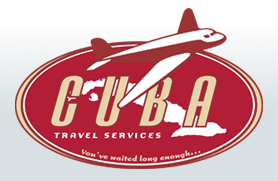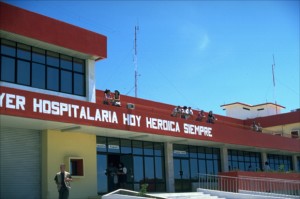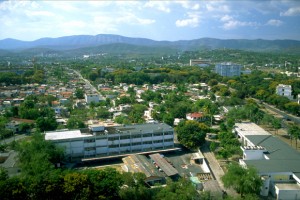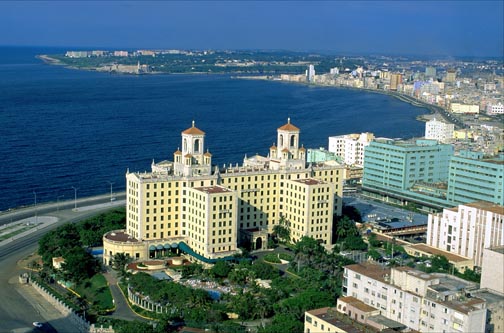P.R.-Cuba flights grounded after 3 months may resume this summer

 Last year, California-based Cuba Travel Services launched, with great fanfare, the first direct charter flights between Puerto Rico and Cuba since the 1959 revolution that brought Fidel Castro to power.
Last year, California-based Cuba Travel Services launched, with great fanfare, the first direct charter flights between Puerto Rico and Cuba since the 1959 revolution that brought Fidel Castro to power.
After only three months, CTS suspended those weekly flights due to lukewarm response from Puerto Rico’s exile community — though word is that the service between San Juan’s Luís Muñoz Marín International Airport and Santiago de Cuba, on the communist-run island’s eastern tip, will resume as early as next month.
Michael Zuccato, manager of CTS in Long Beach, Calif., did not respond to numerous messages left with his assistant.
“Right now, we’re waiting for information,” said a CTS employee who asked not to be identified. “I don’t have a plan at the moment. I was informed that we should be flying again this summer.”
At present, eight charter companies offer flights between the United States and Cuba. For years, the U.S. government authorized such flights only from Miami, New York JFK and Los Angeles, but under more relaxed rules approved by the Obama administration, Cuba charters may now originate in more than a dozen cities including Atlanta, Baltimore, Chicago, Dallas-Fort Worth, Fort Lauderdale, Houston, New Orleans, Pittsburgh, San Francisco and San Juan.
Even so, demand for such service remains limited due to high costs and restrictions on who may travel to Cuba — both consequences of Washington’s 50-year-old embargo against the Castro regime.
“My understanding is that the demand was not quite as great as they anticipated,” said Tampa businessman Bill Hauf, president of Island Travel & Tours Ltd. “Secondly, the flight only went to Santiago de Cuba and not Havana. If it had gone on to Havana, obviously more passengers would have been interested.”
History-making move falls short
Hauf had hoped to make history this March with the first-ever direct air service between the Washington, D.C., area and Cuba. But those plans fell through when he couldn’t sell enough tickets to make the charters worthwhile.
“We needed more time to make people aware,” Hauf said. “Under DOT regulations, until we choose an exact date, I can’t promote flights to Cuba. But clearly we’ll have to do more promotion because groups take four or five months to prepare for. We’re looking at this fall as a starting point because by then, there should be sufficient demand.”
Official data from Miami International Airport, the top U.S. gateway to Cuba, show that after a 55 percent jump in 2010, the number of passengers leaving MIA for Cuba rose only 5 percent in 2011 to 335,335. About 1,500 passengers also flew charters from Fort Lauderdale and another 3,500 from Tampa in 2011. Combined, that’s still less than 350,000 passengers taking charters from Florida to Cuba last year — far fewer than many operators had hoped.
In addition to the high costs, there’s also a small but extremely vocal minority of Cuban-American exiles in South Florida who are bitterly opposed to such flights. Perhaps that’s why CTS is keeping a low profile.
Late last month, the Coral Gables office of Airline Brokers Co. — which flies five times a week to Havana and twice a week to Cienfuegos from Miami and Fort Lauderdale — was destroyed in a blaze that FBI officials say was deliberately set.
The agency’s owner, Vivian Mannerud, criticized the reluctance of Miami politicians to denounce what she called “a terrorist act on U.S. soil.” The fire, which was so intense that steel beams nearly melted and the office building had to be condemned, was reminiscent of similar attacks in Miami and Puerto Rico in the 1970s and 1980s.
In April 1979, Carlos Muñíz Varela, owner of Viajes Varadero, was gunned down in San Juan; recently declassified FBI documents indicate his murder was coordinated with local help from Coordinadora de Organizaciones Revolucionarias Unidas (CORU), a coalition of five anti-Castro terrorist groups established in Santo Domingo.
20,000 Cuban exiles live in P.R.
In Puerto Rico, the Cuban exile community numbers around 20,000, with many of its members coming originally from Santiago de Cuba, on the eastern end of the island, rather from Havana and its environs. That’s why CTS decided to fly to Santiago instead of Havana in the first place — not to mention the much shorter flying time.
The flights themselves utilized American Eagle ATR-72 aircraft departing San Juan every Friday at 9 a.m. and arriving two hours and 20 minutes later. A round trip ticket initially cost $599 but rose to $669 around Christmas season. At any rate, the once-a-week flights were discontinued in late January after only three months in operation.
“My understanding from the feedback I got from passengers is that a lot of people were interested, but that the flights were announced with such short notice that not everybody could travel,” said the CTS employee. “Also, people tend to be a little skeptical. They were waiting for flights to take place so they wouldn’t be stiffed. Some said they’d just wait to see what happens. Others said they never saw the advertising.”
The official said CTS promoted the Cuba flights twice a week for three weeks in the Spanish-language daily newspaper El Nuevo Día.
“Everybody who flew was extremely happy with the service, and the sharpness of the operation,” she told us. “The only complaint I heard was about the cost of excess baggage.”
In fact, that’s a common complaint among all the charter companies offering flights to Cuba. Like most of its rivals, CTS charges $2 per pound.
“Because the flights were only once a week and there was no other possibility of bringing cargo if any bags were left behind, we had to be sure we could board everybody’s luggage, so we limited the number of passengers,” she said.
That means that even though the ATR-72 can seat 64 passengers, Cuba Travel Services was boarding a maximum of 35 people due to FAA weight and balance rules.
“That was the only way we could ensure all the luggage would get there.”
In the meantime, said the employee, “everybody wants to travel through Miami. That’s the only thing I can do at the moment. From Miami, our sister office there offers flights to Havana and Cienfuegos.”








The Obama administration could improve business prospects for charters from cities without large Cuban American populations by four easy steps:
1) Make people to people a self attested general license, just as Cuban Americans have. That would allow families and young people to make substantially less expensive self-directed trips. They would deepen their engagement with average Cubans by renting cars and picking up hitchhikers, or while using the public bus and train, and by staying in privately owned bed and breakfasts.
2) Do away with licensing of Travel Service Providers so every US travel agent and tour operator is motivated to book transportation, accommodations and programs for authorized travelers.
3) Marginalize the cumbersome, politicized, arbitrary and nontransparent OFAC bureaucracy, still led by Bush appointee Adam Szubin. Provide general licenses for travel organized by all IRS recognized not-for profits and third party providers of accredited and university sponsored educational exchange.
4) Give not-for-profit organizations a general license to organize conferences in Cuba for their members and Cuban counterparts.
John McAuliff
Fund for Reconciliation and Development